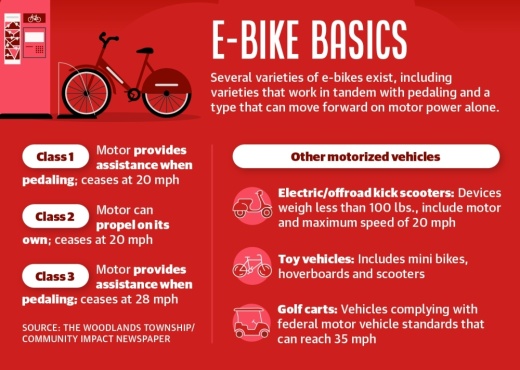As e-bikes, or motorized bicycles, grow in popularity, however, the township is seeking public feedback on whether it should alter that policy to allow the vehicles to be used in their motorized capacity.
The township would need to develop an education program if the vehicles are permitted on pathways, including signage, Parks and Recreation Director Chris Nunes said. The cost of the education program would be about $40,000. However, some cost savings would also be realized if the township no longer painted “No Motorized Vehicles” stencils at 821 locations per year, which costs about $21,000 annually, he said. The cost of removing the stencils would be $300,000, according to township officials.
Resident reaction
Residents on both sides of the issue spoke at a June 23 board of directors meeting, where the measure was tabled to allow further discussion.
Maryann Braid, who said she has served on the Parks and Recreation Advisory Council and worked on the Pedestrian and Bicycle Master Plan, said at the June 23 meeting she was personally concerned about safety on the paths with e-bikes present. At the time the current master plan was formulated, e-bikes did not exist in their present form, she said.
“I believe vehicles riding up to 20 mph is dangerous,” she said at the meeting. “Riding of e-bikes should be allowed to be part of bicycling community in the township but shouldn’t be permitted on the trails.”
The master plan had determined higher-speed vehicles should use roadways rather than pathways, Nunes said.
CT Gooding, the president of the Bike The Woodlands Coalition, came out in support of the vehicles at the meeting.“Bike The Woodlands supports a change to allow e-bikes,” Gooding said. “They are supported by Texas state law and align with policies in bicycle-friendly communities.”
Gooding said there are some benefits associated with the vehicles.
“Electric-assist bicycles make it possible for more people to ride a bicycle and make longer trips,” he said. “They make users feel confident ... navigating wide intersections and difficult terrain.”
Gooding said the coalition would support changing the current policy to a speed limit of 15 mph to help mitigate speed issues expressed by some residents.
Township options
Nunes said there is technically no defined speed limit on pathways, and under current law it has the option to allow e-bikes, which can reach 20 mph or more.
The township orders currently define motorized vehicles as anything that is not human powered, he said. However, several varieties of e-bike can be human powered and have a motorized backup.
A state law, House Bill 2188, permits e-bikes on paths set aside for bicycle use, Nunes said.
“[E-bikes] would be allowed if the pathway was solely identified as a bike path, ... and the board has the option that they may allow e-bikes [on other paths] if they so choose,” he said.
Public input is needed for the township to reach a decision on any changes, Nunes said, which could include gathering input online, at public meetings or through the advisory council. A public hearing would be needed for a policy change, he said.
Editors note: This story was updated to clarify the $40,000 cost was specifically for educational programs and to add that the cost to remove stencils would be $300,000.





